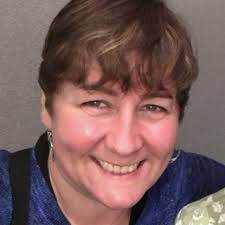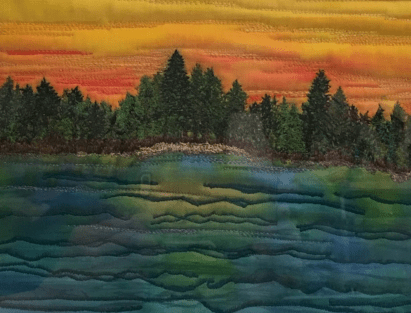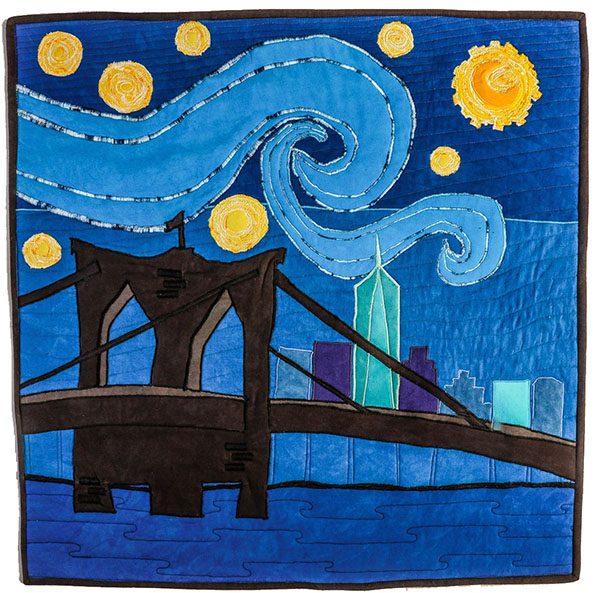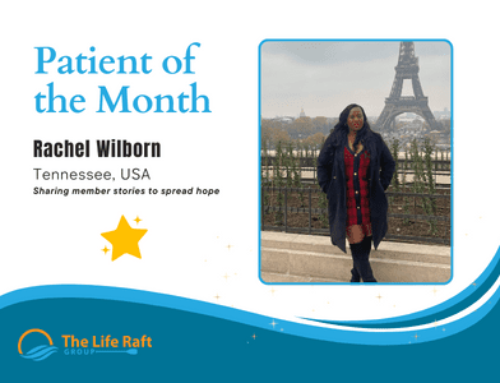Artistic expression is an important psychosocial activity. Sometimes we can express ourselves visually or musically when we can’t express our experience verbally. Music, drawing, painting, and creating sculpture provide a means of communication and self-expression— and a way to alleviate stress. Art also helps us to change our moods, come out of depression, or simply relax. What do people who are already creative do when they are faced with a cancer diagnosis? Does it help or give hope in the situation? In this two-part series, these GISTers – professional and amateur creatives, share their stories.

Claire Monaghan
Claire has always loved art. She counts her grandmother, an embroiderer, and a family friend, a painter named Virginia Cantarella, as strong influences. Claire spent many hours as a child sitting next to her grandmother as her grandmother embroidered monograms by hand on shirt pockets, towels, and handkerchiefs for income. Her grandmother was also known for creating beautiful designs on tablecloths using an Irish embroidery technique called “sprigging.” Claire also spent a lot of time with a close neighbor and friend, Virginia, as she painted realistic landscapes and abstract work.
 Over the years Claire has dabbled in many art techniques. “I enjoy learning how to create art in a variety of ways. Through YouTube videos I learned to weave, twine rugs. crochet and quilt. But quilting has had the biggest impact on me.”
Over the years Claire has dabbled in many art techniques. “I enjoy learning how to create art in a variety of ways. Through YouTube videos I learned to weave, twine rugs. crochet and quilt. But quilting has had the biggest impact on me.”
Claire took one quilting class in her twenties at a local quilting store, Sew Brooklyn, but it wasn’t until twenty years later, before her GIST journey began, that she rediscovered quilting. Claire was working as a preschool teacher at the time and relearned some sewing skills in order to teach her preschool students how to make stuffed animals. She had as much fun as her students during this project and was inspired to continue quilting. “My favorite type of quilting is art quilting. Unlike traditional quilting art quilts are quite like painting with fabrics and thread.
Recently I have realized that my art quilts are in many ways a combination of my love for my granny’s embroidery work and my friend Virginia’s landscape paintings.”
 GIST happened soon after her first quilt was accepted into a quilt exhibit and after participating in her first holiday craft show last December. Every GIST patient has a unique story about how they were diagnosed and where their journey takes them but Claire can literally credit a recurrence of her sister’s ovarian cancer in January as the reason she found her GIST tumor. Claire had decided to have her ovaries removed preventively in response to her sister’s illness and a preoperative sonogram in February revealed a large mass. Initially Claire’s doctors thought the tumor was ovarian cancer but during surgery it was discovered that the tumor was GIST and attached to her small intestines.
GIST happened soon after her first quilt was accepted into a quilt exhibit and after participating in her first holiday craft show last December. Every GIST patient has a unique story about how they were diagnosed and where their journey takes them but Claire can literally credit a recurrence of her sister’s ovarian cancer in January as the reason she found her GIST tumor. Claire had decided to have her ovaries removed preventively in response to her sister’s illness and a preoperative sonogram in February revealed a large mass. Initially Claire’s doctors thought the tumor was ovarian cancer but during surgery it was discovered that the tumor was GIST and attached to her small intestines.
Diagnosed in March 2020, at the beginning of the pandemic, her tumor biopsy showed that Claire had a 10.2 cm small intestinal GIST tumor with a mitotic rate of 35/50 which is considered high risk for a recurrence. Her genetic testing found that she has Exon 11 GIST and she began taking 400 mg of Imatinib in April. Claire’s response to the news of being high risk is to take life “stitch by stitch.” Claire says, “I try not to worry about what is going to happen in the future. I just focus on what I need to do next in my self-care and advocating for myself as well as appreciating my health, family and friends.” Claire says she learned about the importance of Therapeutic Drug Monitoring through the LRG and is eager to continue having her Imatinib levels taken. “I feel it is important individually but also as a GIST community to collect data on Gleevec and Imatinib levels so we can compare it to patient outcomes. We can’t study the data if there is no data.” Claire switched from Memorial Sloane Kettering Cancer Center to Columbia Presbyterian in August because “Dr. Schwartz at Columbia Presbyterian is open to TDM and has created a lab at Columbia Presbyterian that is capable of testing Gleevec/Imatinib levels.”
 Claire has found that creating art has helped during her recovery from surgery and helps with self-care. “I find stitching very calming and therapeutic. I love that I can do it even when I am at home or not feeling my best. I have a studio in my dining room so I always have a space to create when I am able to.” She continued, “You know how when people get cancer they begin thinking about what is on their life bucket list? The nice thing for me is that my bucket list is to spend more time with my family and to create more art and I am able to do both of those things at the same time while at home.”
Claire has found that creating art has helped during her recovery from surgery and helps with self-care. “I find stitching very calming and therapeutic. I love that I can do it even when I am at home or not feeling my best. I have a studio in my dining room so I always have a space to create when I am able to.” She continued, “You know how when people get cancer they begin thinking about what is on their life bucket list? The nice thing for me is that my bucket list is to spend more time with my family and to create more art and I am able to do both of those things at the same time while at home.”
And next for Claire? She recently learned how to create cell like shapes on fabric using a marbling technique. She thinks one of her next projects will be to make a quilt using this newly learned technique to “explore designs with cells, especially GIST cells.” She would also like to make an art quilt to sell as a fundraiser for the Life Raft Group since this organization and its members have “already helped me so much.”
You can see more of Claire’s art at: https://www.facebook.com/ClaireMonaghanStudio




